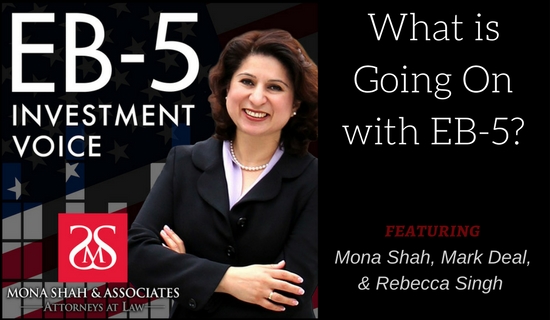
What is going on with EB5? – Episode 39
What is going on? The 411 on EB-5.
Mona, Mark and Rebecca Singh offer insight regarding the latest developments in the EB-5 program. They discuss the rumors circulating around developing legislation, the unprecedented USCIS processing delays, and the criteria for getting a case expedited. The team also covers the good, the bad, and the ugly of the changes reflected in the new USCIS Policy Manual.
What’s going on with EB-5? I’m glad you asked. Today on the podcast, Mona, Mark, and Rebecca provide a status report on the latest developments in the EB-5 program. Mona offers her take on the legislation we can expect come September as well as the significant, across-the-board processing delays currently frustrating clients.
Mona, Mark, and Rebecca also explain the processes in place to expedite a case, and other options one might pursue if their case doesn’t meet the qualifying criteria. Finally, they evaluate the changes to the USCIS Policy Manual published in June, discussing the pros and cons of the newly established guidelines. Listen in to understand how the rules around redeployment put investors at a substantial disadvantage while giving developers enormous leverage.
Forthcoming EB-5 Legislation
- Though there is no definitive news about EB-5 legislation, all signs point to a deal. Mona anticipates another extension come September.
Unprecedented USCIS Processing Delays
- Delays of this magnitude are like nothing we’ve ever seen before, and clients are understandably frustrated. Additionally, all project types seem to be affected.
- Last October, a USCIS representative announced that approved projects would receive deference. Unfortunately, this does not seem to be the case.
- The firm is in constant contact with USCIS, submitting service requests and emailing the Immigrant Program Office. Stay tuned for developments.
The Potential to Expedite a Case
- Certain cases can be expedited, but they must meet specific criteria in order to qualify:
- Severe financial loss to a company or individual
- Extreme emergent situation
- Humanitarian situation
- Nonprofit status of a requesting organization in furtherance of the cultural or social interests of the United States
- Department of Defense or national interest situation
- USCIS error
- Compelling interest of USCIS
- If your case does fit one of the criteria, it is necessary to submit both an expedite request as well as the EB-5 application.
- The key word is compelling. The firm has had successful requests to expedite cases, but only under very serious circumstances, i.e.: critical medical conditions.
Employing the Ombudsman as a Last Resort
- If your case does not fit one of the criteria to expedite, another option involves the Office of Citizenship and Immigration Services Ombudsman. The Ombudsman’s role is to assist individuals and employers in resolving case problems with USCIS.
- The Ombudsman functions as an impartial entity, independent of USCIS, but is not an appellate body. The Ombudsman can make requests but does not have the authority to command USCIS.
- The Ombudsman is a last resort. The firm must follow the protocol of calling USCIS, submitting a service request, sending a follow-up email and scheduling an InfoPass appointment before enlisting the help of the Ombudsman.
- EB-5 is different from other immigration programs when it comes to aged-out children. In EB-5, the case must be filed prior to the child turning 21. In situations of USCIS error, significant delays or lost files, the Ombudsman is a practical option – though it may take 90 days for the process to begin.
- The Ombudsman generates regular reports that include very telling information, i.e.: the IPO has 90 unfulfilled positions – which explains the incredible processing delays. The Ombudsman’s most recent report also revealed that there are 58,000 pending petitions and 30,000 people waiting for immigrant visas; these numbers far exceed the quantity of available visas. The queue for dependents from mainland China is nearly ten years.
Constructive Changes to the USCIS Policy Manual
- The updated Policy Manual published on June 14th clearly defines the ‘period of sustainment’ as two years from the date the investor obtains conditional residence. This eliminates confusion regarding how long an investor’s money must stay inside the project.
The Consequences of Redeployment
- One change to the Policy Manual that is deeply problematic involves redeployment of investor capital. Redeployment occurs when investment capital is returned to a developer, and he then reinvests the money in other projects.
- An investor’s money must remain at-risk until the I-526 is approved. Adjudication delays prevent developers from returning money to investors, so it is often redeployed to other projects.
- There is some debate surrounding whether redeployment is required under the law. USCIS has recently implied that it is required, while Mona and many colleagues disagree. Redeploying an investor’s capital introduces additional risk (that the investor did not agree to) while giving the developer enormous leverage.
- With billions of dollars available, the new rules around redeployment are ripe for fraud and investment in riskier projects. If it is established that the money needs to stay at-risk, a regulatory body must be put in place to oversee the redeployment of capital.
- Check out MONA’S REDEPLOYMENT BLOG POST for more information on this.



